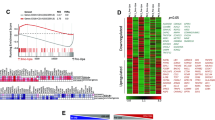Abstract
We recently described mutual antagonism between IFN-gamma and TNF-alpha on human fibroblast-like synoviocytes (FLS). TNF-alpha inhibits IFN-gamma-induced HLA-DR expression and IFN-gamma blocks TNF-alpha-dependent synoviocyte proliferation, collagenase production, and GM-CSF secretion. To study the mechanism of antagonism we have analyzed the effect these factors on the expression of cytokine surface receptors.125I-Labeled cytokine binding was measured on cultured FLS and the results were analyzed by Scatchard plots. Unstimulated synoviocytes expressed 9300 ± 1560 IFN-gamma binding sites per cell. A single class of high-affinity receptor was observed (K d=4.5±2.5×10−10 M). TNF-alpha did not competitively inhibit125I-IFN-gamma binding. When FLS were incubated with TNF-alpha (100 ng/ml), there was a paradoxical 49.5 ± 5.6% increase in the number of binding sites for IFN-gamma (P=0.001), with no change in theK d. Unstimulated FLS also expressed 2850 ± 700 TNF-alpha receptors per cells, with a singleK d consistent with the lower-affinity TNF-alpha receptor (7.4±0.2×10−10 M). IFN-gamma did not directly interfere with TNF-alpha binding. Preincubation of FLS with 100 U/ml of IFN-gamma resulted in a 28.9 ± 9.0% increase in TNF-alpha receptor expression (P<0.008), with no change in theK d. Low levels of the soluble 55-kD TNF receptor were detected in FLS supernatants. IFN-gamma did not effect soluble TNF receptor production. These data are the first demonstration of IFN-gamma and TNF-alpha receptors on FLS and show that TNF-alpha and IFN-gamma increase the expression of each other's receptor. Therefore the mutual antagonism between these two cytokines must occur through a postreceptor mechanism.
Similar content being viewed by others
References
Firestein GS, Zvaifler NJ: How important are T cells in chronic rheumatoid synovitis? Arth Rheum 33:768–773, 1990
Alvaro-Gracia JM, Zvaifler NJ, Firestein GS: Cytokines in chronic inflammatory arthritis. V. Mutual antagonism between IFN-gamma and TNF-alpha on HLA-DR expression, proliferation, collagenase production, and GM-CSF production by rheumatoid arthritis synoviocytes. J Clin Invest 86:1790–1798, 1990
Firestein GS, Zvaifler NJ: Peripheral blood and synovial fluid monocyte activation in inflammatory arthritis. II. Low levels of synovial fluid and synovial tissue interferon suggest that gamma-interferon is not the primary macrophage activating factor. Arth Rheum 30:864–871, 1987
Firestein GS, Alvaro-Gracia JM, Maki R: Quantitative analysis of cytokine gene expression in rheumatoid arthritis. J Immunol 144:3347–3353, 1990
Elias JA, Gustilo K, Baeder W, Freundich B: Synergistic stimulation of fibroblast prostaglandin production by recombinant interleukin-1 and tumor necrosis factor. J Immunol 138:3812–3816, 1987
Henderson B, Pettipher ER: Arthritogenic actions of recombinant IL-1 and tumor necrosis factor α in the rabbit: Evidence for synergistic interactions between cytokines in vivo. Clin Exp Immunol 75:306–310, 1989
Scharffetter K, Heckmann M, Hatamochi A, Mauch C, Stein B, Riethmuller G, Ziegler-Heitbrock HL, Kreig T: Synergistic effect of tumor necrosis factor and interferon-gamma on collagen synthesis of human skin fibroblasts in vitro. Exp Cell Res 181:409–419, 1989
Elias JA, Krol RC, Freundlich B, Sampson PM: Regulation of human lung fibroblast glycosaminoglycan production by recombinant interferons, tumor necrosis factor, and lymphotoxin. J Clin Invest 81:325–333, 1988
Bethea JR, Gillespie GY, Chung IY, Benveniste EN: Tumor necrosis factor production and receptor expression by a human malignant glioma cell line, D54-MG. J Neuroimmunol 30:1–13, 1990
Raitano AB, Korc M: Tumor necrosis factor up-regulates γ-interferon binding in a human carcinoma cell line. J Biol Chem 265:10466–10472, 1990
Bolton AE, Hunter WM: The labeling of proteins to high specific radioactivity by conjugation to a125I containing chelating agents. Application to the radioimmunoassay. Biochem J 133:529, 1973
Firestein GS, Zvaifler NJ: Autoimmune arthropathy: Rheumatoid synovitis.In Autoimmune Diseases II, NR Rose, IR Mackay (eds). San Diego, Academic Press, 1992, pp 363–385
Gray PW, Leong S, Fennie EH, Farrar MA, Pingel JT, Fernandez-Luna J, Schreiber RD: Cloning and expression of the cDNA for the murine interferon gamma receptor. Proc Natl Acad Sci USA 86:8497–8501, 1989
Raitano AB, Scuderi P, Korc M: Upregulation of interferon-gamma binding by tumor necrosis factor and lymphotoxin: disparate potencies of the cytokines and modulation of their effects by phorbol ester. J Interferon Res 11:61–67, 1991
Brockhaw M, Schoenfeld H-J, Schlaeger E-J, Hunziker W, Lesslauer W, Loetscher H: Identification of two types of tumor necrosis factor receptors on human cell lines by monoclonal antibodies. Proc Natl Acad Sci USA 87:3127–3131, 1990
Hohmann H-P, Remy R, Brockhaus M, van Loon APGM: Two different cell types have different major receptors for human tumor necrosis factor (TNFα). J Biol Chem 264:14927–14934, 1989
Schoenfeld H-J, Poeschi B, Frey JR, Loetscher H, Hunziker W, Lustig A, Zulauf M: Efficient purification of recombinant human tumor necrosis factor β fromEscherichia coli yields biologically active protein with a trimeric structure that binds to both tumor necrosis factor receptors. J Biol Chem 266:3863–3869, 1991
Hohmann H-P, Brockhaus M, Baeuerle PA, Remy R, Kolbeck R, van Loon APGM: Expression of the types A and B tumor necrosis factor (TNF) receptor is independently regulated, and both receptor mediate activation of the transcription factor NF-kB. TNFα is not needed for induction of a biological effect via TNF receptors. J Biol Chem 265:22409–22417, 1990
Browning J, Ribolini A: Studies on the differing effects of tumor necrosis factor and lymphotoxin on the growth of several human tumor lines. J Immunol 143:1859–1867, 1989
Zuckerman SH, Schreiber RD: Up-regulation of gamma interferon receptors on the human monocyte cell line U937 by 1,25-dihydroxyvitamin D3 and granulocyte-macrophage colony stimulating factor. J Leukocyte Biology 44:187–191, 1988
Fischer T, Wiegmann K, Bottinger H, Morens K, Burmester G, Pfizenmaier K: Regulation of IFN-gamma-receptor expression in human monocytes by granulocyte-macrophage colony-stimulating factor. J Immunol 145:2914–2919, 1990
Van Bladel S, Libert C, Fiers W: Interleukin-6 enhances the expression of tumor necrosis factor receptors on hepatoma cells and hepatocytes. Cytokine 3:149–154, 1991
Author information
Authors and Affiliations
Rights and permissions
About this article
Cite this article
Alvaro-Gracia, J.M., Yu, C., Zvaifler, N.J. et al. Mutual antagonism between interferon-gamma and tumor necrosis factor-alpha on fibroblast-like synoviocytes: Paradoxical induction of IFN-gamma and TNF-alpha receptor expression. J Clin Immunol 13, 212–218 (1993). https://doi.org/10.1007/BF00919974
Accepted:
Issue Date:
DOI: https://doi.org/10.1007/BF00919974




